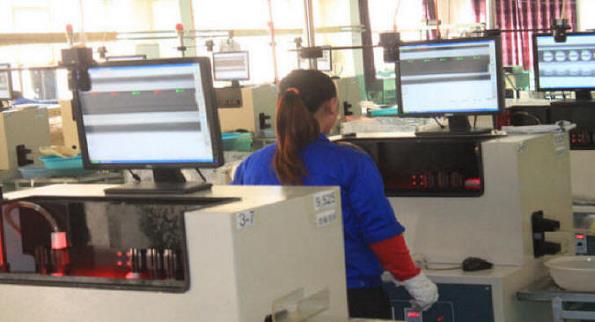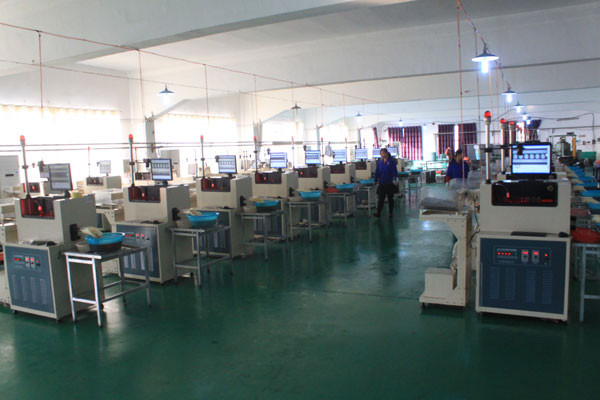
The fine polishing of steel balls, for
high precsion,
reach to the standard requires of steel ball by
customer, G28, G10, G5
Fine grinding and ultra-fine
grinding of steel balls are the final processing
procedures of steel balls. For steel balls above G40,
ultra-fine machining process is generally adopted. The
final dimensional deviation, geometric accuracy, surface
roughness, surface quality and burn of the steel ball
shall meet the technical requirements of precision or
ultra precision machining process.
When checking the diameter deviation and geometric
accuracy of steel ball, it must be measured on the
specified special instrument. After finishing, the
workpiece surface roughness and surface quality are
tested, which is generally used for visual inspection
under spotlight. In case of dispute, the 90x magnifying
glass can be inspected and compared with the
corresponding standard photos. In order to inspect the
surface quality and roughness of workpieces after
superfinishing, a certain number of workpieces must be
sampled 90 times with a magnifying glass and inspected
with standard photos. When there is visual doubt about
the surface roughness, it can be tested on the surface
roughness meter.
Burn examination was performed by random sampling. The
quantity and quality standard of sample inspection shall
meet the requirements of burn standard.
The reasons for poor surface roughness are as follows:
1. The processing quantity is too small and the
processing time is too short.
2. The groove of the grinding disc is too shallow and
the contact surface between the groove and the workpiece
is too small.
3. The hardness of the grinding disc is too high or
uneven, as well as trachoma and porosity.
4. Excessive addition of abrasive paste or
coarse-grained abrasive.
5. The groove of the grinding panel is too dirty, with
iron filings or other sundries.
The main reasons for the poor local surface roughness
are: the groove of the rotary grinding disc is too
shallow, the contact area of the workpiece is too small,
the groove angle of the grinding disc is too small, and
the rotation of the workpiece is not flexible. The
pressure app lied
on the upper grinding panel is very small, resulting in
sliding between the workpiece and the grinding panel. lied
on the upper grinding panel is very small, resulting in
sliding between the workpiece and the grinding panel.
Surface wear is also a common defect in circular
machining. In severe cases,
there are obvious pits under the astigmatism lamp. Only
one black or yellow can be seen in the light. However,
the pit can be seen at 90 times magnification. The lower
part of the pit is rough and the scratches are uneven.
The reason is: the groove depth of the grinding disc is
different. The workpiece in the deep groove sometimes
stays and sometimes slides due to low pressure,
resulting in grinding at the contact between the
workpiece and the grinding disc; The groove wall of the
grinding disc drops and grinds.
细磨和超细磨是钢球的最终加工工序,对于G40以上的钢球,一般采用超精加工工艺。钢球的最终尺寸偏差、几何精度、表面粗糙度、表面质量和烧伤应满足精密或超精密加工工艺的技术要求。
在检查钢球直径偏差和几何精度时,必须在规定的专用仪器上进行测量。精加工后对工件表面粗糙度和表面质量进行检测,一般用于聚光灯下的目视检测。在争议的情况下,可以对90倍放大镜进行检查,并与相应的标准照片进行比较。为了检验超精加工后工件的表面质量和粗糙度,必须用放大镜对一定数量的工件进行90次取样,并用标准照片进行检验。当对表面粗糙度有视觉上的怀疑时,可以在表面粗糙度测量仪上进行测试。
采用随机抽样法进行烧伤检查。样品检验的数量和质量标准应符合烧伤标准的要求。
表面粗糙度差的原因如下:
1.加工量太少,加工时间太短。
2.磨盘的沟槽太浅,沟槽与工件的接触面太小。
3.磨盘的硬度过高或不均匀,以及沙眼和孔隙率。
4.过量添加研磨膏或粗粒度的研磨剂。
5.磨盘的凹槽太脏,有铁屑或其他杂物。
造成局部表面粗糙度差的主要原因是:旋转磨削盘的凹槽太浅,工件接触面积太小,磨削盘的槽角太小,工件的旋转不灵活。上磨盘上施加的压力很小,造成工件与磨盘之间的滑动。
表面磨损也是圆形加工中经常出现的一种缺陷。在严重情况下,散光灯下明显有深坑。在光中只能看到一片黑色或黄色。但是在90倍的放大率下可以看到坑,坑的下部粗糙,划痕参差不齐。其原因是:磨盘的槽深不一样,深槽中的工件由于压力小,有时会停留,有时会滑动,造成工件与磨盘接触处的磨削;磨盘的槽壁出现下降和磨削。 |